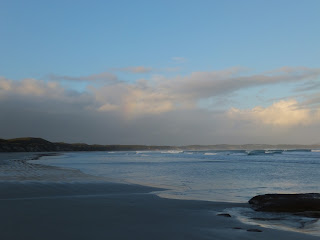These sea stacks have been abandoned to the sea by the retreating headlands as waves and tides crash against the soft limestone rock, undercutting, eroding and carving out rock stacks, gorges, arches and blow holes. And every couple of decades the sea claims another one of these stacks, while more are being created.
 |
| An Australian Black Swan with its chicks on a nest near Princetown in Port Campbell National Park |
 |
| Geoff down on Gibson's Beach |
 |
| Some of the 12 Apostles |
 |
| The fact that these sea stacks are even standing is amazing considering the beating they were taking from the rough surf. |
 |
| The eroded coast line |
 |
| No kidding about what message this sign's trying to get across! |
 |
| Mutton Bird Island (a mutton bird is the local name for a Shearwater). |
 |
| The razorback |
 |
| The beautifully protected bay of Loch Ard Gorge |
 |
| London Bridge - well, half of it anyway.... the 2nd arch (next to Lucy's head) collapsed in 1990 leaving two surprised tourists stranded on the worlds newest island. |
 |
| The long white curve of beach in Bridgewarer Bay |
 |
| A Pied Oystercatcher looking for dinner. |
 |
| Lucy could almost fit inside the "tree-trunks". Note the wind power turbines in the background. These littered the coastline east of the apostles. |
 |
| Nothing inside, but a very tree like outline kept us puzzled until we found an information board, |
 |
| Regardless of the explanation for the "forest" it was a very interesting and beautiful spot. |

Nice pictures. Enjoy your six months off travelling. A great thing to do. Maybe try entering the Great Ocean Road facebook competion to revisit the area. Did you try the iPhone App?
ReplyDeleteEven more interesting... is that the 2 "tourists" who were caught on the other side of London Bridge when it collapsed were in fact having an affair at the time. Needless to say, nature ensured that they were caught out!
ReplyDeleteWow,amazing looking place!
ReplyDelete